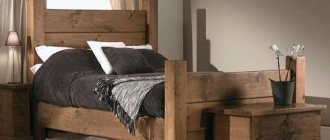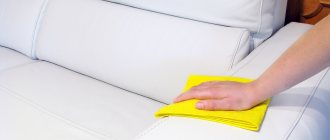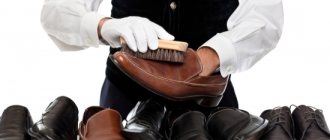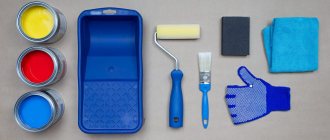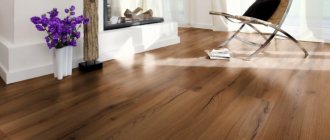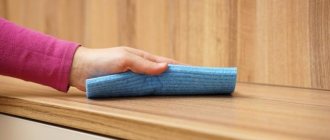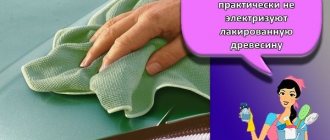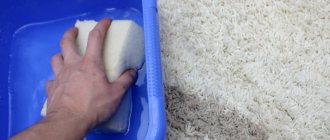Home/Articles/Furniture care. How to polish furniture to make it look expensive?
During operation, even high-quality furniture fittings gradually lose their appearance. Small scratches and chips appear on the surfaces, and the color fades. In addition, wooden furniture can absorb grease, after which stains remain on the surfaces, which are very difficult to get rid of. But this does not mean at all that the fittings need to be replaced with new ones. There are several simple methods that will help restore furniture to a presentable appearance.
Beer and wax
When wood fittings begin to fade, scratches appear on the surface and the color gradually changes. A simple home remedy based on beer and wax will come to the rescue. Pour one glass of beer (dark) into a saucepan, add a teaspoon of wax and bring to a boil over low heat. After the solution has cooled, it is applied to the surface and allowed to dry. Only after the solution has completely dried and hardened is the surface polished to a shine using a woolen cloth. This product will help eliminate minor scratches, restore the damaged glossy structure and create a protective film.
Traditional methods of cleaning lacquered furniture
In addition to expensive chemical polishes, which often have a very strong odor and are poorly tolerated by people with allergies, you can use folk remedies to clean furniture at home. Few people know that it is possible to renew the varnished surface of a table or bedside table, remove stains left by hot objects, or wipe off droplets of wax and glue with the help of flour, table vinegar, soap, milk and other products that are always found in the household.
Fresh spots
Oily finger stains stand out especially strongly on shiny surfaces. Furniture covered with such prints looks sloppy. There are several techniques to quickly get rid of traces of grease on polishing:
- A piece of laundry soap is soaked in water and the surface of the furniture is wiped with a soft cloth soaked in a soap solution.
- Grease stains are lightly sprinkled with flour, talcum powder or baby powder. Wait 10–15 minutes until the bulk product absorbs the fat, then wipe with a soft, clean cloth.
- Rub the contaminated surface with a potato tuber cut in half. 15 minutes after treatment, polish the table with a cotton cloth.
- Mix alcohol and vegetable oil, taking equal amounts of ingredients, and rub the furniture with this mixture.
- You can wash lacquered furniture with milk. Soak a napkin in milk, wring it out and wipe the area of contamination. Remaining liquid is removed with a dry cloth.
Whatever cleaning product is used, the job should always be completed by polishing to a high shine using a soft flannel.
Old pollution
To remove old stains, you will have to use more aggressive products with salt and acid.
- Using table salt you can remove marks left by hot dishes. To do this, wrap a handful of salt in a handkerchief, moisten the bag in vegetable oil and rub the damaged surface.
- Old stains are removed with 9% vinegar. If you leave acid on a furniture surface for a long time, the varnish may crack, so you need to act as quickly as possible, and after cleaning, carefully remove any remaining vinegar with a dry cloth.
- To clean the polish, tea leaves are useful. After drinking tea, put it in a cloth and wipe the furniture.
- Sauerkraut brine is a great way to remove dirty stains from polish.
We recommend: How to remove mold from a baby stroller and wash fabric elements?
Droplets of frozen wax that accidentally fall on the polished table during the celebration should be cleaned off with a wooden stick or spatula, and then wipe the area of contamination with a swab soaked in vinegar.
Vinegar and ammonia
In one glass of water, add a third of a glass of ordinary table vinegar and one coffee spoon of ammonia. In this solution, you need to moisten a napkin (for washing dishes) and wipe the surfaces well. This product can eliminate even the most stubborn grease stains and remove old plaque without damaging the surface structure.
Inventory preparation
Glazing wood is a fairly simple process that doesn't require much effort. There are a large number of ways to do this, but this article will discuss the simplest one. It assumes the following inventory:
Blueberries lower cholesterol and blood pressure: says nutritionist
Doctor Alexander Myasnikov told Russians about products for longevity
Coconut cake with vanilla cream and chocolate spread: a light dessert recipe
- brush for mixing components;
- brush for applying glaze;
- container for preparing glaze;
- paper towels;
- steel wool (oil-based glaze).
That's all that will be needed for glazing furniture. As you can see, the list is minimal, so you don’t have to buy any expensive tools or specialized equipment.
Restoration
If you want to return the furniture to its high value and its former appearance, it is best to carry out restoration. Of course, restoration is only possible if the furniture is made of natural wood. First, the surfaces are cleaned of old varnish. If there are small chips, deep cuts or dents, they are masked with a special putty. Next, a new layer of varnish is applied. Experts recommend using varnish with shades, since old wood tends to lose its natural color over time.
Preparatory work
Adding shine to furniture is called glazing. Before you start, you need to make sure that the item already has a base coat. If it is missing, then you need to start with the finishing. For this, you can use any materials except natural resins, for example, shellac. They are very difficult to remove from work surfaces, so if you make even the slightest mistake, the furniture will simply be damaged.
Polish
The simplest and most effective way to restore the presentable appearance of furniture is to use special polishes. They are based on synthetic oils and fibers that fill microcracks on surfaces. These products have a pleasant smell and are very easy to use. Polishes contain three main components: antistatic, silicone and wax. Regular use of polishes will help restore damaged wood structure and significantly extend its life.
How to wipe polished furniture for shine?
In order for your favorite furniture to last as long as possible and always please the eye with a clean, sparkling surface, it must be regularly wiped with special polishes or popularly known means.
- Burdock oil is excellent for finishing varnished surfaces. This inexpensive product is sold in pharmacies. It is better to purchase a composition without additional fragrances. The method of use is very simple: apply a little burdock oil to a gauze or cotton napkin and rub it over the varnish surface.
- The shine of polished furniture will be given by treating with vegetable oil mixed in equal proportions with table vinegar.
- Beer will help keep polished furniture clean and shiny. The drink (1 glass) is poured into a saucepan, a piece of paraffin candle is placed there and heated until the wax melts. The composition is cooled and applied to the cabinet doors or table surface. Remaining liquid is removed with a dry cloth.
Any action, regardless of the type of cleaning composition, should end with a thorough polishing with flannel or suede.
It is difficult to prevent dust and dirt from getting on polished furniture. However, if you carry out simple maintenance in a timely manner, which consists primarily of removing dust and antistatic treatment of the varnish surface, you will be able to enjoy the look of a stylish and presentable interior for many years.
Useful tips for caring for furniture
To extend the life of furniture and prevent loss of its appearance, follow these recommendations:
- Once a month, wipe surfaces with soapy water. Simply lather your hands with laundry soap in a small amount of warm water and wipe the furniture with this solution. This will keep it from fading.
- If fingerprints from oily fingers are visible on surfaces, you should use cosmetic talc. Apply a small amount of talcum powder to a rag and blot the stains.
- If stains from water or spilled products are very visible on the furniture, prepare a mixture of wheat flour (1 cup) and sunflower oil (a tablespoon). Treat all areas with streaks and remove any residue with a cotton napkin.
- Surface scratches can be masked with shoe polish by selecting the desired shade.
You should not get rid of old furniture, especially if it is made of natural wood. Using such simple means at hand, you can quickly and effectively restore the presentable appearance of your furniture.
AlinaAuthor of the article
Did you like the article?
Share with your friends:
Types of stains on polished furniture
Polished furniture attracts dust more than any other. This can be explained very simply. A smooth surface, not treated with an antistatic agent, attracts dust particles and small specks, which are clearly visible on the mirror surface of the tabletop. The task becomes more complicated if there are small cracks or scratches on the surface of the table or cabinet doors: it is much more difficult to deal with dirt that has clogged up in microcracks than with dust on a flat surface.
In addition, the following types of contaminants are clearly visible on polishing:
- fingerprints;
- accidentally spilled liquid;
- paraffin, wax, plasticine;
- imprints left by a cup of hot tea or a heated frying pan.
In any case, you need to know how to clean polished furniture without risking harm to your favorite table or cabinet.
How to remove polish from wood
Nowadays polishing is not in fashion. Often it loses its shine and looks ugly. Modern surfaces have a matte color. The cleaning method is selected taking into account the composition of the varnish.
The old polish is removed with a grinding machine. Replace it with coarse sandpaper, remove the coating layer to light wood. Then it is processed with fine grain, leveling the surface.
For the second cleaning option, you will need a piece of glass. Use the sharp edges of the shard to scrape off all the polish. After removing the layer, smooth out the irregularities with sandpaper.
There is a chemical method for removing the coating. They buy ready-made polish removal products and work with them only in an open room wearing protective clothing and a respirator. Cover the surface with the preparation, let it stand, then remove the top layer. Each product has its own instructions and method of use.
